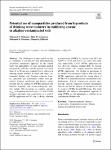Item Infomation
Full metadata record
| DC Field | Value | Language |
|---|---|---|
| dc.contributor.author | Moharem, Mohamed L. | - |
| dc.contributor.author | Hamadeen, Hala M. | - |
| dc.contributor.author | Mesalem, Mohamed O. | - |
| dc.date.accessioned | 2023-08-07T08:03:28Z | - |
| dc.date.available | 2023-08-07T08:03:28Z | - |
| dc.date.issued | 2023 | - |
| dc.identifier.uri | https://link.springer.com/article/10.1007/s10653-023-01663-z | - |
| dc.identifier.uri | https://dlib.phenikaa-uni.edu.vn/handle/PNK/8729 | - |
| dc.description | CC_BY | vi |
| dc.description.abstract | The stabilization of heavy metals in soils is considered a cost-effective and environmentally sustainable remediation approach. In the current study, the applicability of water treatment residual nanoparticles (nWTRs) with the particle size ranged from 45 to 96 nm was evaluated for its efficacy in reducing arsenic mobility in clayey and sandy contaminated alkaline soils. Sorption isotherms, kinetics, speciation and fractionation studies were performed. Sorption equilibrium and kinetics studies revealed that As sorption by nWTRs-amended soils followed Langmuir and second-order/power function models. | vi |
| dc.language.iso | en | vi |
| dc.publisher | Springer | vi |
| dc.subject | nWTRs-amended soils | vi |
| dc.subject | Potential use of nanoparticles | vi |
| dc.title | Potential use of nanoparticles produced from byproducts of drinking water industry in stabilizing arsenic in alkaline-contaminated soils | vi |
| dc.type | Book | vi |
| Appears in Collections | ||
| OER - Khoa học môi trường | ||
Files in This Item:

